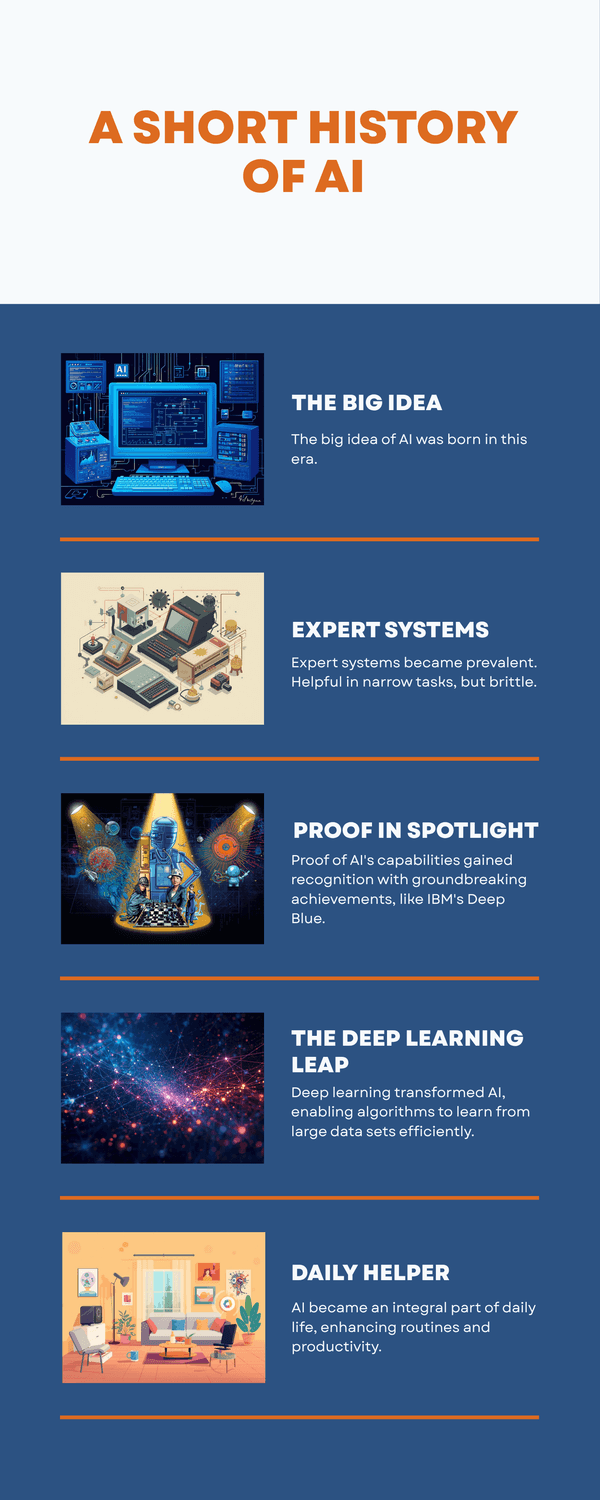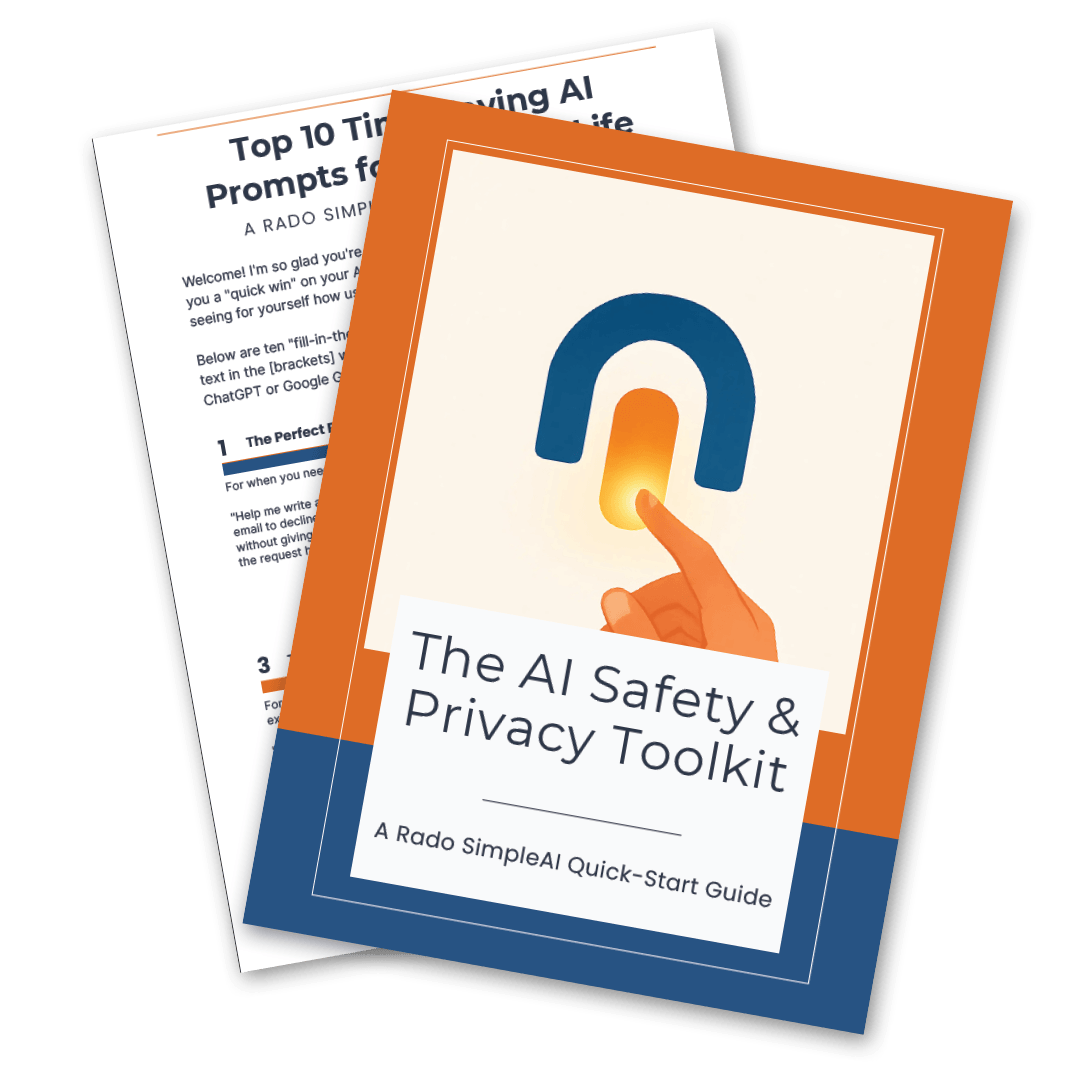What Is Artificial Intelligence? A Beginner’s Guide for Adults 45+ (2026 Edition)
By Rado
AI can feel like a mystery box; powerful, confusing, maybe even a little intimidating. If you’ve ever thought, “Do I need a science degree to understand this?”, you’re not alone. The good news: you don’t need to be a tech whiz to grasp the basics. In this guide, we’ll strip away the jargon and show how AI already works in your daily life, why it matters, and how you can use it with confidence.
What exactly is Artificial Intelligence?
You open your phone, it unlocks by recognizing your face, your maps app suggests a quicker route to the doctor, and your bank pings you about a suspicious charge. None of that feels like sci‑fi, it just works. The quiet helper making those choices is artificial intelligence.
In plain English, AI is software that tries to mimic parts of human thinking, like learning from examples, noticing patterns, and making decisions. Think of it as a student that studies lots of past cases, then gets better at answering new ones. Agencies and tech leaders describe it this way too, from NASA to IBM. The key difference from regular automation is that AI adapts with experience. Your calculator never improves, but your email spam filter does, because it keeps learning what you mark as junk.
Where might you already be using it? Face unlock learns your features over time. GPS apps watch traffic and reroute you before a jam forms. Streaming services suggest a film similar to what you liked last week. Voice assistants understand, “Remind me at 3 pm to call mom,” then create the reminder. Have you noticed how these tools quietly remove small hassles, one by one?
You might be wondering, “Do I need to understand the math behind it?” No. Just as you can drive a car without knowing how the engine is built, you can use AI safely by learning a few simple cues. For example, check privacy settings, review what data an app collects, and choose tools that explain what they do with your information. Many adults want this kind of control. A Pew Research Center (2025) report found high awareness of AI and a strong desire for transparency and choice.
It’s normal to feel cautious, especially if tech changes faster than you’d like. That’s a fair concern. The encouraging news is that familiarity builds confidence. The National Poll on Healthy Aging (2025) notes that older adults who have tried AI tools are more confident using them than those who haven’t. So, what’s a smart first step? Pick one everyday task you already do and try an AI assist, such as letting your phone draft a tidy reply to a long email, or asking a voice assistant to add a pharmacy pickup to your calendar. How would your day feel if five minutes of fiddling turned into one tap and done?
Here’s a simple way to remember it: automation repeats, AI improves. The more it sees, the better its suggestions become. And you stay in the driver’s seat by choosing when and how to use it.
The takeaway: AI is a learning tool that quietly reduces everyday friction, from maps to email. Start small, keep an eye on privacy, and let confidence grow with experience.
How does AI actually work?
Let’s say you’re planning a weekend trip. You say, “Show me photos from last summer near the lake,” your phone pulls up the right album, Maps suggests a route that avoids a football game, and your notes app drafts a packing list from your voice. Helpful, right? Under the hood, three pieces work together: AI (the big idea), machine learning (pattern-spotting), and deep learning (very good at images, speech, and complex predictions).
Think of it like nested dolls. Artificial intelligence is the outer doll; the goal of making computers perform tasks that usually require human thinking. Machine learning sits inside it: algorithms learn from examples rather than fixed rules. And inside that, deep learning uses layered “neural networks” inspired (loosely) by the brain to handle messy data like pictures and audio (see IBM; NASA).
Here’s a kitchen analogy. Imagine a pizzeria: the host takes your order (understanding language), the prep station shapes the dough (extracting features), the oven finishes the bake (final prediction). Each station improves with practice. That’s a neural network—layers pass work forward, and the system adjusts its “recipe” based on mistakes until the pizza reliably turns out right.
So how does it learn? With training data. A spam filter shows thousands of emails labeled “spam” or “not spam.” Over time, it notices patterns, odd sender names, certain phrases and scores each new email. That’s classic machine learning. When your photo app recognizes your dog or your phone understands “Call Anna at 3,” that’s deep learning, trained on many images or voice samples to map pixels or sound waves to meaning.
You might be wondering, “Do I have to feed it my private data to make it useful?” That’s a fair question. Many tools learn from large, public or synthetic datasets; personal features like your voice profile or face map are typically stored privately on‑device or behind opt‑in settings you can review (check the app’s privacy page). It’s normal to feel cautious here; take thirty seconds to open Settings → Privacy and see what’s being saved and why.
Another piece you’ll hear about is reinforcement learning. Learning by trial and feedback, like rewarding a GPS when it picks a route that actually saves time. Over many trips, it gets better at predictions. Still, an honest reminder: these systems are not sentient. They find patterns and make statistical guesses, which can be wrong in surprising ways. That’s why a quick human glance—does this route look sensible?—is still wise.
Ready to try it for yourself? Ask your assistant to “summarize this email,” let Photos “find pictures of the red car,” or have Maps “avoid tolls.” Which tiny headache could you trade for a one‑tap assist today?
The takeaway: AI is the umbrella, machine learning is how it learns from examples, and deep learning is the powerful sub‑type for images, speech, and complex tasks. Start with simple, low‑risk uses (voice, photos, summaries) and keep privacy settings in your control.

A short history of AI — from theory to your pocket
Imagine flipping through an old photo album. The early pages are black‑and‑white, then color appears, then everything becomes digital. AI’s story feels similar: early ideas, slow experiments, then a steady march into the tools you use every day.
1950s–1960s: The big idea. In the post‑war years, researchers asked a bold question: can a machine “think”? The period gave us famous thought experiments like the Turing Test and the birth of the term “artificial intelligence.” The goal wasn’t magic; it was teaching machines to solve problems with rules and logic. (Overviews: IBM, NASA.)
1970s–1980s: Expert systems. Early programs tried to capture human expertise as “if‑then” rules. Helpful in narrow tasks, but brittle; when the world changed, the rules broke. You might be wondering, why does this matter now? Because it explains why modern AI moved beyond fixed scripts toward systems that learn from data.
1990s–2000s: Proof in the spotlight. In 1997, a chess system defeated the world champion—impressive, but still specialized. In 2011, a question‑answering system won a quiz show on live TV. Those moments signaled to everyday people that AI wasn’t just a lab project; it could parse language, weigh evidence, and choose answers in real time (timeline overviews: IBM).
2010s: The deep learning leap. Cheap storage, faster chips, and oceans of data let neural networks flourish. Your phone began recognizing photos, transcribing speech, and translating text with accuracy that felt “good enough” for daily use. So, you might ask, is this when AI became practical? For many of us, yes, this is when features like photo search (“find pictures of my dog”) started to feel natural.
2020s: AI as a daily helper. Conversational models made it simple to ask for a summary, a draft, or a plan in plain language. Streaming apps recommended what to watch, maps predicted traffic, and banks flagged suspicious transactions; often without you noticing the helper behind the scenes. Public awareness and use have climbed sharply in recent years, along with a desire for control and clear guardrails (see Pew Research Center (2025)).

Where does this leave you today? You don’t need to memorize the timeline. But it helps to see the pattern: from rigid rules → to learning systems → to friendly tools in your pocket. The direction has always been the same; make computers better at handling messy, real‑world tasks so you spend less time on fiddly steps and more time on what matters.
Three quick checkpoints as you move forward:
Look for tools that explain how they use your data;
Start with small, useful tasks (summaries, reminders, photo search);
Keep your settings tidy—privacy first, convenience second.
The takeaway: AI grew from lab ideas into everyday helpers by shifting from hard‑coded rules to learning from data. You don’t need the whole history; you just need to know that today’s tools are built to be practical. Start where the benefit is obvious, keep your privacy settings tight, and build confidence step by step.
Why does AI matter for adults 45+?
Let’s make this practical. Picture a Tuesday: your watch nudges you to stand and sip water, your calendar suggests leaving ten minutes earlier because rain slowed traffic, and your banking app quietly blocks a suspicious charge. Wouldn’t a day like that feel a little lighter? That’s the point of AI for our stage of life; less hassle, more control.
Here’s the short version: AI helps with time, safety, and independence. Many of us want results without tinkering, and that’s reasonable. In fact, adults 45+ often say they value convenience but want transparency and choice; clear settings, clear benefits (see Pew Research (2025)). So, what does this look like day to day?
Time & energy back. Small automations add up. Among workers who use generative AI, average time savings are about 5.4% of work hours; roughly two hours in a 40‑hour week (St. Louis Fed, 2025). Even if you’re semi‑retired or freelance, tools that draft emails, summarize long messages, or plan errands reduce mental load. You might be wondering, will this make me feel less capable? It’s normal to worry about that. Most people report the opposite: fewer “fiddly” tasks means more focus for what matters.
Financial safety, without babysitting every transaction. Fraud is getting smarter and faster. AI defense meets it in real time, spotting odd patterns and stopping damage in milliseconds (DataDome). Reported U.S. fraud losses topped $10 billion in 2023, pushed higher by sophisticated scams (Thomson Reuters, 2025). Does this mean you have to become a cybersecurity expert? No. It means choosing banks and tools that clearly explain their alerts and let you confirm actions with one tap.
Health and independence. Wearables and home sensors are shifting care from reactive to proactive. Studies show AI models can detect and classify fall patterns with around 83% sensitivity, making alerts faster and prevention smarter (Journals of Gerontology, 2025). Add simple wins (medication reminders, sleep tracking, gentle activity nudges) and you’ve got tech that supports “stay in my home, on my terms.” That’s a powerful promise.
Yes, concerns are valid and manageable. Many older adults are open to helpful AI but want guardrails around privacy and human contact. For example, AARP reports enthusiasm for tech that saves time on travel, alongside worries about relevance and privacy (AARP, 2024). The healthiest stance is practical: use tools that tell you when you’re interacting with AI, provide an easy‑to‑find privacy panel, and let you opt in (or out) of data sharing.
So, ask yourself: Which small frustration could AI remove this week? Drafting replies? Sorting photos? Flagging duplicate charges? Confidence grows with firsthand experience; adoption rises sharply once people try one or two low‑risk tasks (National Poll on Healthy Aging, 2025).
The takeaway: For adults 45+, AI matters because it returns time, strengthens fraud protection, and supports health habits that keep you independent. Start small, pick tools with clear privacy controls, and let the benefits prove themselves—one practical win at a time.
Common myths about AI: what’s true and what’s not?
You’ve probably seen a headline that made you pause: “AI will take every job,” “No one understands how it works,” or “Privacy is gone.” Over coffee, a friend might say, “I’m too old for this tech.” If any of that sounds familiar, you’re not alone. Let’s sort myth from reality so you can make calm, confident choices.
Myth 1: “AI will take all the jobs.”
Reality: AI is best at repetitive, data‑heavy tasks. Humans excel at judgment, relationships, and creativity. Research shows AI often saves time on routine work (about 5.4% of work hours for users), freeing people for higher‑value tasks (St. Louis Fed, 2025). Ask yourself: what could you hand off (drafting emails, formatting notes) so you can focus on coaching a teammate or planning the project?
Myth 2: “AI is a black box nobody can explain.”
Reality: Explainability is a growing requirement, not an afterthought. Industry guidance and regulations push developers to mark AI outputs and make decisions traceable (see IBM on AI transparency; policy momentum in finance via U.S. Treasury, 2024). You might be wondering, how do I benefit from this? Look for products that tell you when you’re interacting with AI and provide plain‑language “why this decision” summaries.
Myth 3: “AI is sentient.”
Reality: Today’s systems don’t have feelings, beliefs, or common sense. They detect patterns and make statistical guesses. Treat them like smart calculators: useful, fast, occasionally wrong. A quick human glance (does this suggestion make sense?) keeps you in charge (overview primers: IBM, NASA).
Myth 4: “Only tech experts can use AI.”
Reality: The best tools hide the complexity. Voice assistants, photo search, and summarized emails are designed for everyday use. Older adults who’ve tried AI report more confidence than those who haven’t—experience beats theory (National Poll on Healthy Aging, 2025). It’s normal to feel hesitant; start with one simple task you already do.
Myth 5: “Privacy is hopeless.”
Reality: You still have meaningful levers: opt‑in settings, on‑device processing, and clear privacy dashboards. Consumers also want transparency and control; a trend confirmed in recent surveys (Pew Research, 2025). Practical habit: open Settings → Privacy once a month, review data sharing, and turn off what you don’t need. In regulated sectors like finance, governance frameworks and audits are now table stakes (ISACA; U.S. Treasury, 2024).
Two quick checkpoints for peace of mind:
Prefer tools that show when AI is used and why it made a suggestion.
Keep your privacy controls tight; look for on‑device options and easy opt‑outs.
The takeaway: AI doesn’t replace your judgment; it removes busywork. It isn’t sentient, and it isn’t beyond explanation. Start with small, useful tasks, choose tools that are transparent about decisions and data, and you’ll keep the benefits while staying in control.
How can AI help me in daily life?
Imagine a calm morning. You say, “What’s on today?” and your phone answers with a short plan, adds a pharmacy stop between errands, and drafts a polite reply to yesterday’s long email. No drama, just fewer moving parts. That’s everyday AI; small assists that give you time back.
1) Productivity without the fuss
Start with tools that tidy what already clutters your day. Email and note apps can summarize, draft, and set reminders from plain speech. Workers who use generative AI report saving about 5.4% of work hours (roughly two hours in a 40‑hour week) by handing off routine tasks to an assistant (St. Louis Fed, 2025). You might be wondering, will it sound like me? Most tools let you edit the draft; think of it as a head start you fine‑tune.
2) Smarter shopping and planning
AI assistants can compare products, check specs, and surface reviews in one place, acting like a friendly store clerk who knows your budget and preferences (App0, 2025). Ask, “Find a mid‑priced cordless vacuum that’s light and good for pet hair,” and you’ll get a focused shortlist. Practical tip: keep one or two non‑negotiables (price, warranty) and let the assistant filter the rest.
3) A home that looks out for you
Today’s smart devices go beyond “on/off.” Doorbell cameras can recognize packages and alert you by name; thermostats learn your routine to reduce bills; leak sensors spot problems early (Digicrusader, 2025). Prefer simplicity? Start with one useful device; say, a thermostat and add more only if you see clear value. It’s normal to ask, is this safe? Choose brands with clear privacy dashboards and strong authentication.
4) Health habits and peace of mind
Wearables can nudge movement, track sleep, and even assist with fall detection. Research reports around 83% sensitivity when AI models classify fall patterns, which can speed alerts and prevention (Journals of Gerontology, 2025). Medication reminders and appointment prompts are simple wins that support independence. If you’re thinking, I don’t want another screen, go voice‑first: “Remind me at 8 pm to take the blue pill.”
5) Staying connected, not isolated
AI companions and chat tools can provide friendly conversation, check‑ins, and “don’t forget” prompts. Reviews of tools for older adults show measurable reductions in loneliness when social robots and assistants are used thoughtfully (NIH/PMC, 2024). That said, they’re supplements, not substitutes; use them to support more human time, not replace it.
Quick safety habits:
• Open Settings → Privacy monthly and review what’s shared.
• Prefer tools that say when you’re interacting with AI and why it made a suggestion (Pew Research, 2025).
• For banking and payments, keep alerts on; AI can flag fraud in milliseconds (DataDome).
Two reflection questions: Which tiny headache would you hand off first—email replies, photo search, or trip planning? What would you do with the 30–60 minutes you get back?
The takeaway: Use AI where the benefit is obvious; summaries, reminders, shopping comparisons, smart home basics, and health nudges. Keep privacy settings tight, start with one task, and let confidence grow from those easy wins.

How to start using AI with confidence
Let’s keep this friendly and doable. Picture a simple goal for this week: answer long emails faster and stop worrying about missing a bill notice. With the right picks and a few privacy tweaks, AI can help without taking over. You’re in charge.
Step 1: Pick one tiny use‑case and test it for 7 days.
Choose a task you already do: drafting replies, summarizing articles, or setting reminders. Ask your assistant, “Summarize this email in 3 points,” or “Add a pharmacy pickup Friday at 16:00.” Edit anything you don’t like; the tool is a helper, not the final word. Confidence grows fastest with firsthand experience; older adults who’ve tried AI report higher comfort than non‑users (National Poll on Healthy Aging, 2025). What’s the smallest win you want this week?
Step 2: Do a 5‑minute privacy tune‑up.
Open Settings → Privacy in the app (or on your phone) and review:
What data is collected? Turn off anything you don’t need.
Where is data processed? Prefer on‑device options when available.
Can you opt out of training? Many tools now offer this.
People want transparency and control; recent surveys confirm it (Pew Research, 2025). If a tool won’t explain itself in plain language, that’s a red flag. For an overview of good transparency practices, see IBM’s explainer. It’s normal to feel cautious here; five calm minutes beats guessing.
Step 3: Add two safety rails.
Banking alerts on. Let AI flag strange charges in milliseconds so you can confirm with one tap (DataDome).
Scam sanity check. If a “relative” calls or messages asking for money urgently, pause and verify with a known number. Voice cloning is getting easier; a 30‑second double‑check prevents headaches (general trend discussed in consumer privacy research: IAPP, 2024).
Step 4: Keep the human in the loop.
Skim AI drafts before sending, glance at route suggestions before driving, and confirm appointments. Today’s systems aren’t sentient; they make statistical guesses and can be wrong. A quick human check keeps you in control (plain‑language overviews: IBM; NASA).
Step 5: Review and reset weekly.
Ask three questions every Sunday:
1) What saved me time?
2) What felt noisy or intrusive; can I turn it off?
3) What’s one new task I’ll try next week?
This keeps the benefits growing while the risk stays low. You might be wondering, Do I have to become a tech expert for this? Not at all. Think of it like tidying a kitchen drawer once a week.
Confidence checklist:
□ One task to try (email summaries, reminders, photo search)
□ Privacy panel reviewed (data on/off, on‑device if possible)
□ Banking alerts on; scam double‑check habit
□ Quick human review before sending/approving
□ 10‑minute Sunday reset
Two reflection questions: What privacy setting did you turn off that gave you peace of mind? Which small task will you hand off next?
The takeaway: Start tiny, tune privacy, add two safety rails, and keep a quick human check in the loop. With that routine, you’ll get the time‑saving benefits while staying firmly in control.

To conclude...
You don’t need to be “techy” to benefit from AI. Start with one small task, keep your privacy settings tidy, and let the tools prove their worth. The pattern you’ve seen across this guide is simple: AI removes busywork, strengthens safety nets, and supports independence; while you stay in charge. If a tool can’t explain what it’s doing or won’t give you controls, skip it. Plenty of options do.
A quick next step: pick one assistant to try this week (email summaries, reminders, or photo search) and set a calendar note to review how it went in seven days. If it saves time or stress, keep it. If not, delete it. That’s confident, practical adoption.
So, your next step? Pick one safe, simple tool and see how it helps. Want a hand getting started? Download my free AI Quick-Start Bundle. It is a step‑by‑step resource designed for beginners who want to use AI wisely, without the overwhelm.
Frequently Asked Questions
1) Do I have to share a lot of personal data to use AI?
No. Many helpful features run on‑device (voice dictation, photo search) and offer opt‑out controls. Look for a clear privacy panel and on‑device processing options; surveys show most people want transparency and choice, and reputable tools increasingly provide it (Pew Research, 2025; IBM: AI transparency).
2) Is it safe to connect AI tools to my bank or payments?
Use providers with instant fraud monitoring and strong authentication. Modern systems can flag suspicious activity within milliseconds, but you should still keep alerts on and confirm actions with one tap (DataDome). If anything feels off, call your bank using the number on the back of your card; don’t trust links from messages.
3) Will AI replace human interaction?
No. Think of AI as a background helper, not a substitute for people. In fact, research on older adults shows certain AI tools and social robots can reduce loneliness when used to support (not replace) human connection (NIH/PMC, 2024).
4) Do I need to be tech‑savvy to try this?
Not at all. Start with one familiar task; “summarize this email” or “remind me at 8 pm.” Experience builds confidence, and older adults who try AI report higher comfort than those who haven’t (National Poll on Healthy Aging, 2025). Keep the human in the loop: skim drafts before sending.
5) Are these tools free or paid?
Both exist. Many phones include free, built‑in features (voice dictation, photo search, basic summaries). Paid apps may add convenience or extra security; before paying, try the free version and review the privacy page; if it won’t explain how your data is used, skip it (IAPP, 2024).
Sources:
NASA — What Is Artificial Intelligence? (2025)
IBM — What Is Artificial Intelligence (AI)? (2025)
Pew Research Center — AI in Americans’ Lives: Awareness, Experiences and Attitudes (2025)
Federal Reserve Bank of St. Louis — The Impact of Generative AI on Work and Productivity (2025)
DataDome — How AI Is Used in Fraud Detection in 2025 (2025)
Thomson Reuters — 2025 Predictions: The Interplay of AI and Fraud (2025)
Journals of Gerontology (Oxford Academic) — Aging With Artificial Intelligence: How Technology Enhances Older … (2025)
National Poll on Healthy Aging (U‑M) — How Older Adults Use and Think About AI (2025)
ISACA — AI and Risk Management: A Strategic Guide for CIOs and CISOs in Financial Services (2024)
U.S. Department of the Treasury — Artificial Intelligence in Financial Services (2024)
NIH/PMC — AI Applications to Reduce Loneliness Among Older Adults: A Systematic Review (2024)
IAPP — Consumer Perspectives of Privacy and AI (2024)
App0 — AI Shopping Assistants: The Future of Personalized Commerce (2025)
Digicrusader —The Future of Smart Homes: 15 AI‑Powered Home Automation Gadgets (2025)

